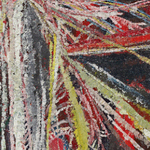Conrad Freiburg at the Hyde Park Art Center
One of the implications of modern cosmology is that we live in an ever-expanding universe. Everything we know to exist will likely expand infinitely until it pulls itself apart. Eventually, the material from all the generations of stars will be exhausted, and the universe will grow cold and dark. Everything will be reduced to nothing.
This gloomy (if not sublime) understanding of the cosmos is likely the best introduction to the work of Chicago-based artist Conrad Freiburg, whose recent show at the Hyde Park Art Center carries the cosmic undertones of an ongoing exploration of what Freiburg sees to be at the center of everything we see and know: the Void.
Since the beginning of last fall, I have had the chance to talk with Freiburg a number of times on the state of his practice. If there is one thing from our conversations that I remember with perfect clarity, it was when he said, “There is Nothing outside the real world, only moments of pushing into the unknown, of expanding the sphere.” For Freiburg, “Nothing” is his religion. As he states in the exhibition press release, “Nothing is in my bones.”
Although you might not think so at first glance, the principles of “Nothing” and the “Void” were the linchpins behind the Freiburg’s extravagant sculptural installation at HPAC.
Aesthetically resembling the interstices between the cosmic apparatus of a 17th century orrery (a mechanical model of the solar system) and the physical grandeur of a planetarium, the simplest way to explain the Pendulum Driven Drawing Machine, as Freiburg calls his 12-foot standing reproduction of a 19th century harmonograph, is that it gives visual form to musical chords and frequencies. Consisting of two pendulums that swing in different lateral directions, and a third that controls independent movement of the drawing surface, the harmonograph creates a series of unique spirals for the rod-operated pen to record on sheets of 8.5 x 11” cardstock, which are then installed throughout the space. Freiburg, who could be seen orchestrating the curvilinear cluster drawings every Sunday afternoon during gallery hours, would stand atop the structure strumming his ukulele. By altering the intervals between frequencies, he fine tunes the motions of the structure to correspond with a musical chord, and is able to “draw” the memorial songs he sings on the tower, songs that he has learned from acquaintances and friends over the years.
In addition to the installed sculptures, paintings and ephemera are displayed in vitrines along the perimeter of the space. The harmonograph has produced nearly 300 intricately and evenly spaced spiral drawings, which are hung up on the wall, nearly touching the top of the 20-foot high ceilings. After asking Freiburg (who had taken a break from his usual Sunday drawing routine) as to why they were hung so high, he grinned and told me to head up to the elevated catwalk opposite the drawings, where he had installed a handmade wooden telescope. The element of exploration built into the viewer’s experience of the show was a brilliant touch, adding an element of humor to the Void without becoming a gimmick.
The whole exhibition ran like a well-oiled machine that mirrors the three-part system Freiburg outlines as defining his ongoing exploration of the Void: absence, loss and the unknown. The cycles of creation and destruction engendered by human-powered mechanisms is at the center of Freiburgʼs artistic universe. Take Self Contained Unit of Entropy (SCUE), for example, an interactive sculpture installed near the back of the space, which allows viewers to create their own sculpture out of old broken pieces of Freiburgʼs own work, and shortly afterward, destroy it.
For this reason, Iʼve always seen Freiburg’s art-making in an alchemical sense: he has the ability to fuse polarizing ideologies and create new outcomes. In the same way, the Void is explored by the mass visual production of an ephemeral event, the viewer is offered a synesthetic experience by being able to see music. Freiburg’s practice is largely based on the ability to define an experience, or rather, a presence, through the definition of its counterpart. Through the translation of incompatible languages, such as drawing and music, “It Is What It Isnʼt” explores the departure between an object and its original referent— in its title as much as it does in its approach to representing how we interpret Freiburg’s sweet strumming.
It Is What It Isnʼt
March 20 – June 26, 2011, Gallery 1
Hyde Park Art Center
5020 S Cornell
www.hydeparkart.org







